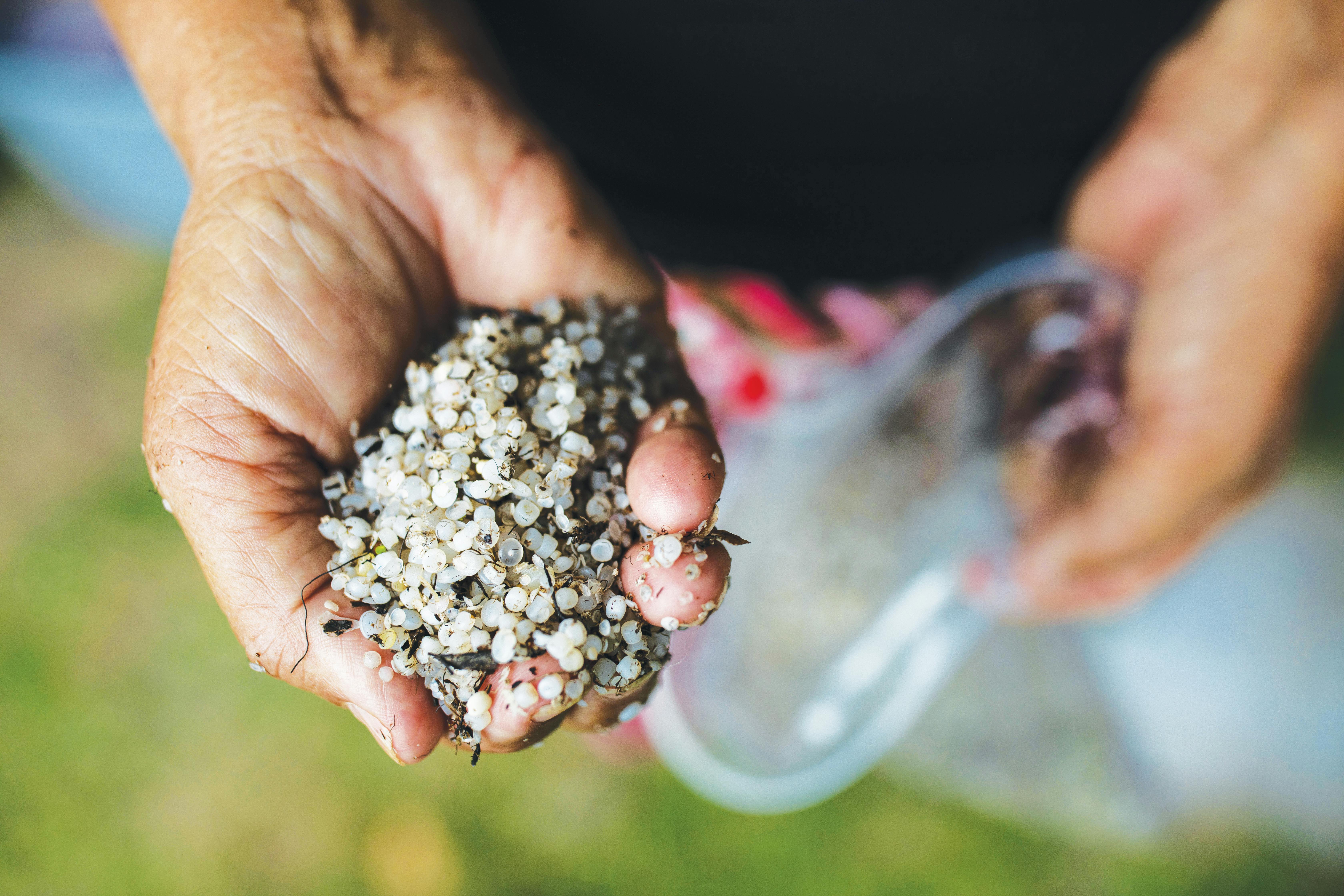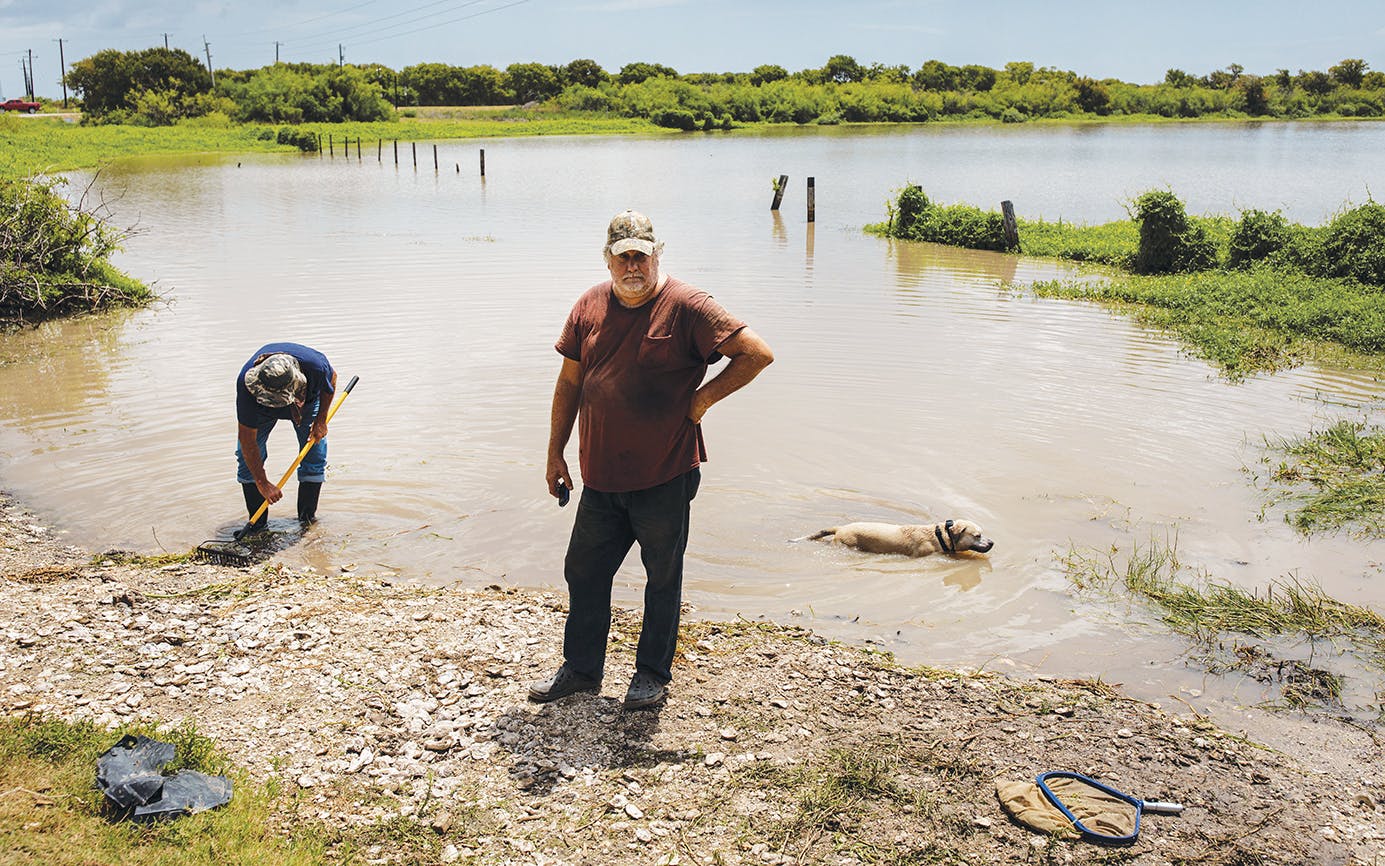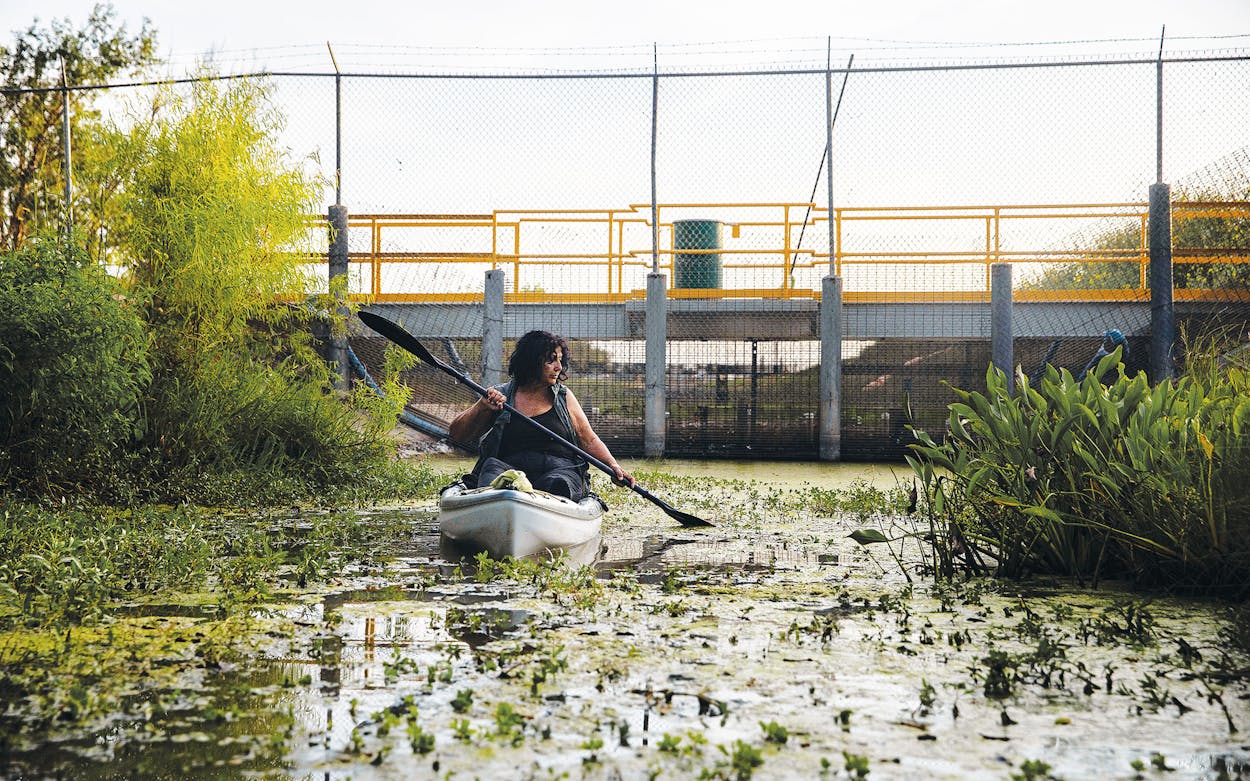One windy winter morning in 2009, a retired shrimp boat captain named Diane Wilson pulled her red Chevy pickup into the parking lot of the Hideout, a metal box of a bar on the outskirts of Rockport. A self-identified “eco-outlaw” and fourth-generation Gulf Coaster, Wilson had spent the previous two decades fighting what she calls a “Diane-versus-Goliath” battle to prevent chemical plants and refineries from polluting the bays that her family has fished, shrimped, crabbed, and oystered for over a century. The week before, Wilson had gotten a call from Dale Jurasek, a former wastewater operator at the Formosa Plastics plant in nearby Point Comfort. He had asked to meet her in person. Wilson had heard of him—in the nineties he had reported his then employer to federal regulators for safety and environmental hazards at the plant. Wilson had her own history with Formosa. In 1994 she tried to scuttle her 42-foot shrimp boat near the outfall where the plant discharges its chemical-laden wastewater, as a “permanent monument to the suffering of the bay.” (The Coast Guard ultimately stopped her.)
When Wilson walked into the bar, Jurasek, who was sitting alone at a table in the corner wearing a cowboy hat and a scowl, waved her over. Then he asked to check her purse for wires. She laughed in surprise. “Hop to it,” she said.
Jurasek had faced retaliation after reporting Formosa, so he was slow to trust strangers. Satisfied that Wilson wasn’t a spy for the company, Jurasek began describing the growing number of plastic pellets inundating Cox Creek, the brackish stream that feeds into Lavaca Bay near Formosa’s plant. Jurasek had first noticed the plastic pellets when he worked at the plant, and in 2000 he had alerted the company to the problem. But after he left his job, he’d spent a lot of time fishing in Cox Creek and Lavaca Bay, and he told Wilson that he began noticing the pellets “everywhere”: in his skiff, on the bottoms of his children’s feet after a day on the bay.
Wilson, who has tousled black hair, deep smile lines, and the squint of a woman raised on the water, is familiar with a dizzying number of harmful sludges, foams, and powders produced by the petrochemical industry. Though she was aware of nurdles, as the plastic pellets are often called, she had never paid them much mind; they seemed minor compared with the contaminated soup that flowed from Formosa into Cox Creek.
The meeting with Jurasek prompted Wilson to investigate on her own. Nurdles, she discovered, are the building blocks of most plastic products and—because of how easily they slip from the supply chain into the environment—of plastic pollution.
A few months later, along with Jurasek and a few other Formosa whistle-blowers, Wilson drove to Cox Creek to see the problem for herself. She didn’t have to look for long: the bank was littered with white pellets. By the boat ramp, not far from where Formosa discharges stormwater, nurdles were caked in the mud to a depth of four inches, Wilson said. “It looked like it had hailed.”
Wilson spent the next seven years contacting state regulators and filing Freedom of Information Act requests to see if Formosa had been disciplined for apparent violations of the Clean Water Act. She found citizen complaints and even photographs depicting nurdles but no record of enforcement. Her sleuthing eventually spurred the Texas Commission on Environmental Quality to reevaluate Formosa’s wastewater permit. During permit negotiations in 2015, Formosa conceded to the TCEQ that releasing nurdles into the environment would “indisputably be a permit violation” that must be reported within 24 hours. Yet the pellets kept coming, and the company never bothered to report the problem to the TCEQ. Wilson finally decided to take matters into her own hands.

Nearly every week since January 2016, she and a scrappy crew of citizens, including Jurasek, have hiked and kayaked along the banks of alligator-infested Cox Creek in search of nurdles. They are organized loosely as the San Antonio Bay Estuarine Waterkeeper, part of a global network of groups affiliated with the Waterkeeper Alliance, a New York nonprofit. Wilson and her Waterkeepers snap photos and use miniature nets from Walmart to scoop pellets into Ziploc bags, which they label with the date, time, and location of the sample. A former Formosa supervisor named Ronnie Hamrick, 65, goes out four or five days a week. (He likes a good rainstorm, because it tends to dislodge nurdles from the weeds.) “If we were trying to pick up everything we could find, there’s no way we’d ever finish, so we take a sample,” said Wilson, who’s 70. “It’s overwhelming sometimes.”
Today, Wilson’s barn at her home in Seadrift contains roughly 30 million nurdles. Along the walls are plastic bins, each one stuffed with sandwich bags full of the pellets—a peculiar inventory resulting from three years of painstaking collection.
Now Wilson’s trove of pellets is part of the evidence against Formosa in a federal lawsuit that could help revolutionize the way citizens hold corporate polluters to account.
The story of a lost nurdle begins and ends in the ground. Drilling companies extract oil and natural gas from the earth and sell the raw fossil fuels to chemical plants that make plastics and synthetic resins. (Forty-six companies have permits to do so in Texas, with more facilities coming soon.) Some plants, such as Formosa, transform molten plastic into pellets. They then sell the pellets to manufacturers that turn them into consumer goods like straws, Styrofoam, and water bottles. Along the way, billions of nurdles—which have an unfortunate tendency to roll and ricochet—escape, spilling onto roads or riding wastewater into the sea.
The origin of the word “nurdle” is unknown, but synonyms abound: scientists who study pollution sometimes use the technical term “plastic resin pellet,” whereas the more whimsical “mermaid tear” is popular among beachcombers. (“Nurdle” has other definitions too, including a strategically gentle shot in cricket and the little blob of toothpaste that sits on the bristles of your toothbrush.) Plastic-industry insiders, meanwhile, favor the bloodless term “preproduction plastic pellet,” a reference to the nurdle’s place in a supply chain that stretches from underground petroleum deposits to grocery-store shelves.
Globally, microplastics—bits of plastic smaller than five millimeters in diameter, including nurdles, microbeads, fragments, fibers, and foam—account for an estimated 85 percent of plastic pollution found on shorelines. And they tend to stick around. Jeremy Conkle, a Texas A&M University–Corpus Christi professor who studies plastics in the ocean, said that plastic can persist in the environment for “hundreds to thousands of years.” Every year, an estimated 250,000 tons of nurdles enter the ocean. According to Eunomia, a UK-based environmental consultancy, they are the second-largest direct source of marine microplastic pollution, after rubber tire dust.
Though the study of nurdles is still in its infancy, researchers have determined that the pellets are vehicles for toxins and pathogens. Pummeled by waves and fried by ultraviolet light, the pellets degrade over time, growing porous and accumulating contaminants such as industrial chemicals and pesticides. Nurdles can contain concentrations of toxins up to 10 million times greater than what’s found in seawater. The pellets also spread harmful bacteria such as E. coli, which colonize the slimy biofilm that forms on submerged plastic. If animals mistake the pellets for food—including endangered species found along the Texas coast, such as the Kemp’s ridley sea turtle and the whooping crane—they can starve to death, their bellies full of plastic that lacks nutrition and defies digestion. Scientists are also concerned that toxins could travel up the food chain from nurdle-eating fish to fish-eating people, posing a serious health risk to humans.
“They’re just accumulating, and they’re not going anywhere,” said Jace Tunnell, a marine biologist at the University of Texas Marine Science Institute in Port Aransas. “We’re at the point now where we need to make a decision. Are we going to keep producing these things without any regulation? Or are we going to say, ‘Look, we’ve had enough. We need to be able to regulate these pellets’?”
On Texas beaches, the lack of regulatory enforcement shows. Like the tar balls that washed ashore in the eighties, plastic has become a coastal plague. A recent study found that from 2015 to 2017, the accumulation rates of marine debris, 93 percent of which is plastic, were ten times greater in Texas than in other Gulf states. Without robust regulation, concerned Texans have resorted to less conventional means of environmental protection, from filing citizen suits to participating in “citizen-science” projects—crowdsourced research campaigns that scientists use to study pollution. By enlisting individuals to collect nurdles and document their findings, researchers can expand the size and geographic diversity of their data sets and make better estimates of the magnitude of nurdle pollution worldwide.

Grassroots projects can also help environmental organizations bring polluters to court. Armed with samples and photos, plaintiffs like Wilson and the Waterkeepers have a better shot at winning lawsuits that often hinge on physical evidence. Kelly Haragan, the director of the environmental law clinic at the UT School of Law, believes that the future of environmental regulation is “people-powered.” Regulators, she noted, currently rely on companies to report their own violations. “We’re on the cusp of the public being able to hold industry much more accountable.”
While the Waterkeepers were building their case against Formosa, Tunnell started a different kind of people-powered nurdle campaign. Last fall, Tunnell was watching the sunset from Bob Hall Pier, on North Padre Island, when he spotted what looked like white foam in the high-tide line—a telltale sign of nurdles. Tunnell called the Coast Guard, which notified the TCEQ, which contacted Tunnell a few days later. He was dismayed to learn that the agency had taken samples but didn’t plan to pursue the problem.
A few months later, in response to the TCEQ’s inaction, Tunnell launched Nurdle Patrol—a research and cleanup campaign that uses crowdsourced data to document the spread of nurdles along the Gulf Coast. In total, 543 “Nurdle Patrollers” removed 172,952 nurdles from Texas beaches between November and July. By tracking how many pellets a single citizen can collect by hand in ten minutes, Tunnell’s team can roughly compare levels of pollution in different areas. Near Galveston Bay, for instance, one woman collected a record-breaking 30,846 nurdles. (Wilson, the previous record-holder, had gathered 16,500 nurdles at Cox Creek.) Similar campaigns in other countries—such as the Great Nurdle Hunt, a global citizen-science project run by a Scottish nonprofit called Fidra—are helping scientists reconstruct the paths of nurdles from their sources through the ecosystem.
On March 25, the first day of the Waterkeeper v. Formosa trial, Wilson and a couple of her fellow kayakers lined up at the door of the federal courthouse in Victoria, towing thirty plastic bins containing an estimated 26 million nurdles. When the security officers, reasonably enough, refused to let them bring in their giant loads of trash, the federal district judge overseeing the trial, Kenneth M. Hoyt, stepped in. Wilson agreed to store the nurdles in the courthouse basement; when the time came, Hoyt and Formosa’s lawyers would troop downstairs to inspect them.
San Antonio Bay Estuarine Waterkeeper and Wilson alleged that Formosa had violated the Clean Water Act by repeatedly discharging huge numbers of nurdles into Cox Creek and had failed to report its pollution to the state a single time since 2016. Though Formosa disputed many of the plaintiffs’ claims, the definition of “trace amount” proved to be the crux of the case. According to Formosa’s permit, the company may release only “trace amounts” of floating solids, including nurdles, into the environment. Formosa’s attorneys argued that the term was ambiguous: by their calculations, it could mean more than nine thousand pellets a day from just Outfall 006, one of twelve points along Cox Creek where Formosa discharges stormwater and wastewater. Besides, they argued, the permit in question was issued in 2016. How could anyone tell whether a nurdle was released yesterday or twenty years ago? Perhaps the nurdles that the Waterkeepers had found were “legacy pellets.” When the answer came out in court, so did a story about a squabble between the Waterkeepers and Formosa’s security detail.
“Have you ever seen any pellets actually exit an outfall?” Formosa attorney Steve Ravel asked Wilson during cross-examination.
“Yes, I have. I’ve been in Outfall 006, literally inside Outfall 006,” Wilson replied. She, Hamrick, and Jurasek had explored the area on foot—before Formosa’s security team banned them from the bank.
“How often?” Ravel asked.
“Well,” Wilson said, “until they stopped us from doing it.”
Formosa disputes that any pellets in excess of trace amounts have exited its outfalls since 2016. It claims that the cleanup crews they hired, equipped with vacuum trucks and hoses, were clearing away pellets released into the creek years before Formosa’s 2016 permit. But scientists testifying for the plaintiffs presented what Hoyt later called “compelling and reliable” evidence that many of the nurdles were new, and the Waterkeepers themselves brought photos and samples of nurdles whose bright white color indicated that they were released recently.
In June, Hoyt ruled in favor of Wilson and the Waterkeepers, writing that Formosa’s violations were “enormous.” Of the engineering expert who defended Formosa’s stormwater systems, Hoyt wrote, “His conclusion is illogical. Formosa cannot be in compliance simply by saying so.”
Hoyt rejected the company’s argument that nurdles existed only in trace amounts in Cox Creek and Lavaca Bay, and he didn’t buy the idea that they were “legacy pellets.” (A spokesperson said the company does not comment on pending litigation. In court filings, Formosa argued that its release of nurdles did not violate the 2016 permit and denied that its practices had harmed the plaintiffs.)
Hoyt also condemned the TCEQ for its “difficulty or inability . . . to bring Formosa into compliance.” Despite numerous citizen complaints and documentation by TCEQ inspectors of nurdles escaping the facility, the agency had fined the company just $122,000.
For the growing cohort of Texas environmentalists focused on plastic pollution, the ruling marked a major victory. There is no comprehensive record of litigation involving nurdles, but anecdotal evidence suggests that Waterkeeper v. Formosa is the first nurdle-centric case to go to trial in Texas and possibly the United States. Amy Johnson, an attorney with Texas RioGrande Legal Aid who represents the plaintiffs, called the case “unprecedented.”
“What’s really powerful and unusual is that our clients gathered the evidence but also that they gathered it in such a tremendously consistent and voluminous manner,” Johnson said. The case has already served as a model for lawyers and citizens across Texas: attorneys from other legal aid organizations traveled to watch the trial, and another client of Johnson’s recently started taking photos of algae growth in a river near her home, downstream from her city’s wastewater treatment plant. “I’ll get a call from some fisherman who’s been out there, and they’ll say, ‘Amy, there’s a whole lot of powder out here today,’ ” Johnson said. “They’re feeling stewardship.”
Hoyt’s emphatic ruling does not necessarily guarantee lasting change, however. Formosa has faced many fines and adverse court rulings over the years. In 1997, under pressure from Wilson, Formosa promised to discharge pollution-free wastewater from its Point Comfort plant in an agreement signed by Wilson, the TCEQ, and the EPA. It was a landmark settlement, but the TCEQ effectively undermined the deal, Wilson argued at the time, by increasing the amount of copper and chloroform the company was allowed to release in its wastewater.
The real test of this citizen-powered litigation strategy will likely come sometime in the fall, when Hoyt is expected to decide how much Formosa must pay in fines. The Waterkeepers are seeking a $166 million penalty, along with an injunction ordering Formosa to comply with its permit—enough, they believe, to compel the billion-dollar company to change its ways.
Still, after Hoyt issued his decision, Wilson sounded ecstatic. “I know what justice feels like,” she said over the phone. “It’s unbelievable. It’s Christmas in July!”

One sunny morning in June, a few weeks before the trial and ten years after their talk at the Hideout bar, Wilson and Jurasek met, as they often do, by the boat ramp at Cox Creek. Miniature net in hand, Wilson searched for nurdles in the weeds. It didn’t take her long to find a cluster of bright white pellets. “I knew those buggers were someplace,” she said.
Even after the trial ended in March, Wilson and her fellow Waterkeepers didn’t stop their work. Hamrick still goes out almost every day, and Wilson averages once a week. Haragan, the UT law professor, considers their project proof that organized citizens can hold polluters—and regulators—accountable. “If you want environmental compliance,” she said, agencies should be enlisting citizens in oversight “rather than putting up barriers.” But years of regulatory inaction have taught the Waterkeepers not to trust the state to safeguard the future of the bay. They see themselves both as stewards and witnesses: as long as nurdles keep coming, they’ll keep collecting.
At Cox Creek, after the group had inspected the shore for nurdles, Wilson dragged a kayak to the beach and hopped in. Jurasek gave her a push.
She stopped a few yards from the thick orange booms that encircle Outfall 006. Formosa has installed the floating structures to help contain nurdles, but nearby, a patch of pellets floated on the open water outside the booms.
In front of her, the plant’s stacks loomed like skyscrapers, skeletal and shining under the scorching South Texas sun. She paused by the cluster of bobbing nurdles, pulled a sandwich bag from her satchel, and reached toward the murk.
This article originally appeared in the October 2019 issue of Texas Monthly with the headline “Nurdles All the Way Down.” Subscribe today.







